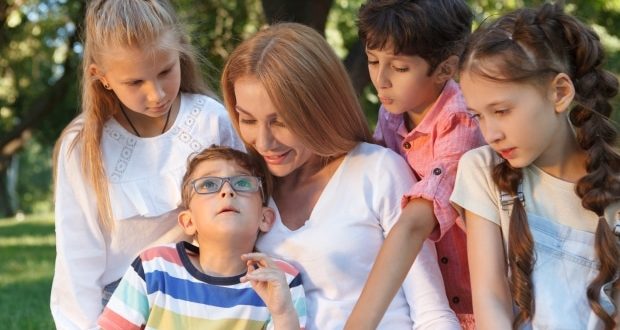Blending a family can be a challenging but rewarding experience where two people create a brand-new family dynamic, including children from previous relationships. However, if you have a child or sibling on the autism spectrum, it can be challenging introducing an autistic stepsibling to their new siblings.
Upon embarking on a new marriage or serious relationship, getting the children on board with their new siblings may take time. Addressing the situation gently and calmly is the best approach to take. Let’s go over a few helpful tips for introducing an autistic stepsibling.
Autism in Children
Autism Spectrum Disorder is a developmental condition where symptoms manifest in children before they turn three. There is no “look” that all autistic children share. But, the disorder usually causes children to interact with the world differently than neurotypical children. Children with autism may communicate, learn, and behave in different ways.
For example, autistic children may have trouble making eye contact with others. They may have a hard time interacting with children their age or engaging in forms of pretend play. They may have difficulty tolerating loud sounds and picking up on other people’s emotions.
Due to different neurological patterns in the brains of autistic children, they may display behaviors that uninformed individuals find abnormal or odd. For example, an autistic child may:
-
Fixate on moving parts of toys rather than the toy itself
-
Obsess over specific topics (sharks, robotics, trains, e.t.c.)
-
Have a compulsion to conduct himself/herself on a strict schedule
-
Move his/her body in repetitive motions to self-soothe (flapping hands, swaying)
Though these behaviors can be challenging to understand, there are many things families can do to ease the process of introducing an autistic sibling to other members.
Autistic Children in Blended Families
Merging two families is often difficult, even under the best circumstances. While there are challenges to be faced, the results are often positive and rewarding. It’s important to understand that there will be ups and downs in any situation where people are being brought together. Ideally, you should hope for the best possible outcome but be prepared for bumps on the road.
Families take time to develop into a cohesive unit where every member respects and values one another. Try not to be discouraged if your autistic child doesn’t bond seamlessly with new family members. It can be difficult for children with autism to meet and interact with new people, even if it’s only for a few minutes. They might be slow to warm up to people they’re going to be around for a long time.
This is why careful planning is essential for introducing a child with autism to new members of their family, especially new siblings. By gently merging and considering the feelings of everyone involved, you can start your adventure as a new family.

Introducing an Autistic Child To Other Siblings
When you’re planning to introduce an autistic child to their stepsiblings, it should include what will occur before the actual introduction, during the introduction, and after the stepsiblings have met their special needs sibling.
Before
Before the introduction occurs, it’s a good idea to talk to the new siblings in two separate groups. Talk to the child’s new stepsiblings and discuss what autism is along with some of the expected behaviors a special needs child may engage in. Open the floor for questions.
Prepare the stepsiblings, so they don’t walk into this new interaction completely blind. Cover the basics of autism and how it relates to your child. But, try not to overload them with more information than they need. There will be time to reflect later.
You should also speak with the special needs child before introducing them to their new siblings. Let the child know what will happen, who these new people are, and when the event will take place. By preparing both parties, they know what to expect during the meeting.
During
During the introduction, give everyone space and don’t expect them to warm up to one another immediately. Both parents should be present and attentive, and both should encourage the children to interact with one another. The meeting can be a simple event at home or another safe, quiet setting. The introduction can be simple if you’ve prepared the children ahead of time.
You could say something like, “Danielle and Marie, this is Darius. He is your new stepbrother. Darius, this is Danielle and Marie. They are your new stepsisters.” Allow the children to interact with one another. If they’re feeling shy or apprehensive, gently suggest conversation topics without being too forceful.
Try not to overload the children by making them spend the day together during their first meeting (unless they’re getting along). Keep the first introduction short and plan for long, fun activities during family events.
After
After the children have met for the first time, leave the floor open to questions and concerns. This is a perfect time for learning more about autism and creating a welcoming environment for learning. Each child may have specific things they would like to address. Being communicative can ensure that the children learn about each other in healthy ways.
The children asking questions or expressing thoughts about the interaction are making an effort to understand. The more answers you provide, the more you’re helping the children get to know one another. Take time to check in on your autistic child. Ensure that they have not become overstimulated and give them time to decompress after the meeting. Once they’re ready, allow them to ask questions about the other children as well.
Things To Consider
There are several unique circumstances to consider when introducing an autistic sibling to other children. Keep these points in mind when navigating your approach to merging your family.
The other children may have questions that hurt their feelings
This is especially true if these children have had no other exposure to people on the autism spectrum. Try to understand that most of the time, children don’t mean to be hurtful when they ask questions about people with special needs.
Of course, don’t allow the other children to bash your autistic child or sibling verbally. But try to understand the meaning behind what they’re thinking. Use this opportunity to inform them about autism, the child as an individual, and how to use proper wording for these situations.
An autistic child’s characteristics may make socializing hard
For example, many autistic children are non-verbal. This means talking to their stepsiblings isn’t possible. Try to adjust the meeting so that you can accommodate an autistic child’s needs (like their need for strict routines) and avoid potential difficulties.
Consider talking to your child’s/sibling’s doctor
The doctor who diagnosed your child with autism will have many resources you can use. Tell the doctor about your plans and ask for professional advice based on what they know about their patient.
Be prepared to address misconceptions and confusion
It’s not uncommon for people to have a basic understanding of what autism is. But, if these people have absorbed harmful information about the disorder, they may be misguided.
Even organizations that allegedly seek to “help” people with autism can harm autistic people with misinformation. An example of this can be seen in the problematic information in Autism Speaks’ marketing.
This makes many people confused and afraid about autism and autistic people. Be prepared to address incorrect facts about autistic people. They may be hurtful to hear, but boundaries need to be set.
The first meeting between the children might go poorly
This is okay. Getting children to develop a positive familial relationship with one another takes time. Just because it didn’t go well upon the first meeting doesn’t mean the situation won’t improve.
Do your best to remain positive. Tomorrow is another day and another opportunity to try and get the children to support one another positively.

Activities for Autistic Children & Their Families
After you’ve introduced an autistic child to their stepsiblings, things may be going well enough that you’d like to plan some fun activities for the children to do together. Depending on the abilities and preferences of the children, you might want to consider the following activities for family outings.
-
Obstacle courses (age/ability appropriate)
-
Swimming
-
Hiking trips
-
Bike riding
-
Board games
-
Playground activities
-
Scavenger hunts (age/ability appropriate)
Additionally, feel free to ask the children for input. Based on their suggestions, choose a few activities ideal for everyone in attendance.

Autism Resources
As your blended family evolves, you may need more help with addressing the needs of your autistic child. Take a look at several reputable organizations designed to support people with autism. Most of these organizations have board members or leaders on the spectrum. These organizations work to help people with autism and those who love them.
-
Autism Society (US): This organization features many helpful resources to help autistic children thrive. They also assist families by providing support and understanding.
-
Nonspeaking Community Consortium: This Facebook support group is designed to help nonverbal children and their families.
-
Foundations for Divergent Minds: This organization posts helpful, interesting information from the POV of neurodivergent individuals (tips on safety, sensory needs, parenting, e.t.c.).
-
Autistic Self-Advocacy Network (ASAN): This organization is a network that provides helpful resources and advocacy efforts for neuro-divergent individuals and their families.
-
Asperger / Autism Network (AANE): This organization has a list of helpful resources to help all people on the autism spectrum, from childhood to adulthood. There are also resources for family members, friends, and professionals.
Conclusion
Remember to stay positive and remain calm. When you introduce children to a merging family, you’re likely to face your fair share of challenges. The children may take time to warm up to one another. But, keeping everyone in good spirits during this significant life change will help make the transition proceed as smoothly as possible.
Also, don’t forget autism is a spectrum, and the individuals on the spectrum are just that: individuals. No two autistic children are the same. By knowing and loving the child you’re introducing, you can guide them through the process in ways that you both understand.
Have a plan, take it slow, and empathize with everyone’s feelings. Blending a family can be challenging, and the transition may be difficult for your autistic child and/or new siblings. Be informed and ready to educate others if it’s necessary.
Have open conversations and be prepared to embrace possible challenges along the way. Be advocates for your autistic child, and remember that everything will be okay. Here’s how aquariums can help your autistic child.






